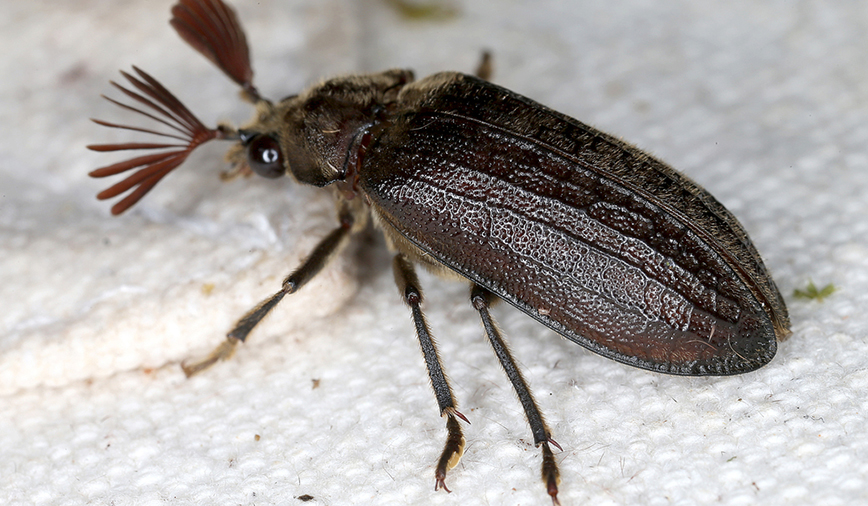I bumped into an old friend the other day as I was walking along Second Street in Geneva. It had been awhile since we’d last met, which was all the more reason, I thought, to stop and get reacquainted with—and to introduce others to–this little, and little-known, neighbor.
Meet Sandalus spp., a member of an extraordinary genus of insects known as the cicada parasite beetles.
I first learned of these guys a few years ago when one, quite literally, dropped in on us during a third-grade field trip we were hosting out in the Hickory Knolls Natural Area. One of our instructors, Kim Haag, was directing the students in an activity when she happened to look down. Hooked onto her leg was not, thankfully, a third grader, but rather in insect that measured about an inch long—big enough to notice, yet not so large as to be daunting or scary.
Mostly brown, with a black pronotum (the plate-like structure behind the head), his coloring was attractive but not remarkable. Its antennae, though, were nothing short of spectacular.
Another of our intrepid instructors, Jeanette Joy, who had been playing the role of a Potawatomi Native, came over and agreed that the beetle was unlike any she had seen before. Clad in traditional Native attire, and surrounded by artifacts that dated back hundreds of years, Jeanette reached for the most relevant tool she could find—her cell phone–and proceeded to snap several pictures of the decidedly unique critter.
From there, the race was on to identify the little bugger. Thanks once again to our favorite on-line field guide, BugGuide.net, it wasn’t too hard to track down the beetle’s family, Rhipiceridae, the cedar beetles. As beetle families go, this one’s pretty small, with only one genus—the aforementioned Sandalus–and five species occurring in North America.
I’m hesitant to try to identify this insect down to species, since very little is known about the family. But to me, the exact name doesn’t matter as much as what its ecological niche, or job is.
Sandalus beetles parasitize cicada nymphs and serve as an important means of controlling the cicada population. Female beetles are gifted with the ability to track down the slits in tree branches where female cicadas laid their eggs. The female beetles lay their eggs in or near the same location, which sets the stage for the next astounding phase in this fascinating insect’s life cycle.
Sandalus larvae go through what is known as hypermetamorphosis. Whereas most baby beetles spend their immature life stages as lumpy grubs, young Sandalus larvae start out as triungulins—silverfish-like creatures with well-developed legs, which they use to dig down, down underground, to where the cicada nymphs are feeding on tree roots.
Once attached to nymph, the larvae assume a more grub-like form; they feed and molt several times before finally pupating and emerging as adults. From there the race is on to find a partner and get that next generation started before winter’s cold sets in and the current members dispatch for good.
One adaptation adult Sandalus individuals share with many other types of insects, and one that aids in expediency during this final life stage, is that they have no need to feed. Their nutrient requirements were fulfilled in their larval phase, by those underground cicada nymphs.
Right now—which is quite late in the year, at least in our area, for insects to be procreating—female cicada parasite beetles are gathering on tree trunks, probably near where they emerged from the ground. Males fly about, relying on those fantastic antennae to detect the females’ chemical cues.
The unusual timing of this activity, combined with the unmistakable antennae on Sandalus males, makes this a fun activity to track down and observe. The female beetle I found in Geneva was right at the corner of Second and State Streets, so that might be one place to look. Another is the Hickory Knolls Natural Area; there the beetles tend to pop up near the old archery course mid-way through the 130-acre parcel. Besides the male that landed on Kim three years ago, I’ve found several females on the gravel trails and old roadbeds in that region of the park.
If you should be lucky enough to find one, or some, take some notes on where, when and what it, or they, were doing. Even better, take some photos too. Then, if you get a chance, let me know what you’ve found.
In the process, you’ll get to know a new friend, and I can get better reacquainted with an old one.
***
If you’re a fan of things like cicada parasite beetles, you may be interested in meeting others who share that special sort of enthusiasm. If so, mark your calendars for the first week in December. The coordinating partners of Kane County Certified Naturalists, a year-long, adult-level nature education program, are ramping up for another fun-filled session that will begin in January. We will be holding KCCN information meetings on Thursday December 1 at 7 p.m. at Hickory Knolls, and again on Saturday December 3 at 10 a.m., at Creek Bend Nature Center, which is located within LeRoy Oakes Forest Preserve on Dean Street in St. Charles. I’ll be there; hope you will too!
Pam Otto is the manager of nature programs and interpretive services at the Hickory Knolls Discovery Center, a facility of the St. Charles Park District. She can be reached at 630-513-4346 or potto@stcparks.org.

